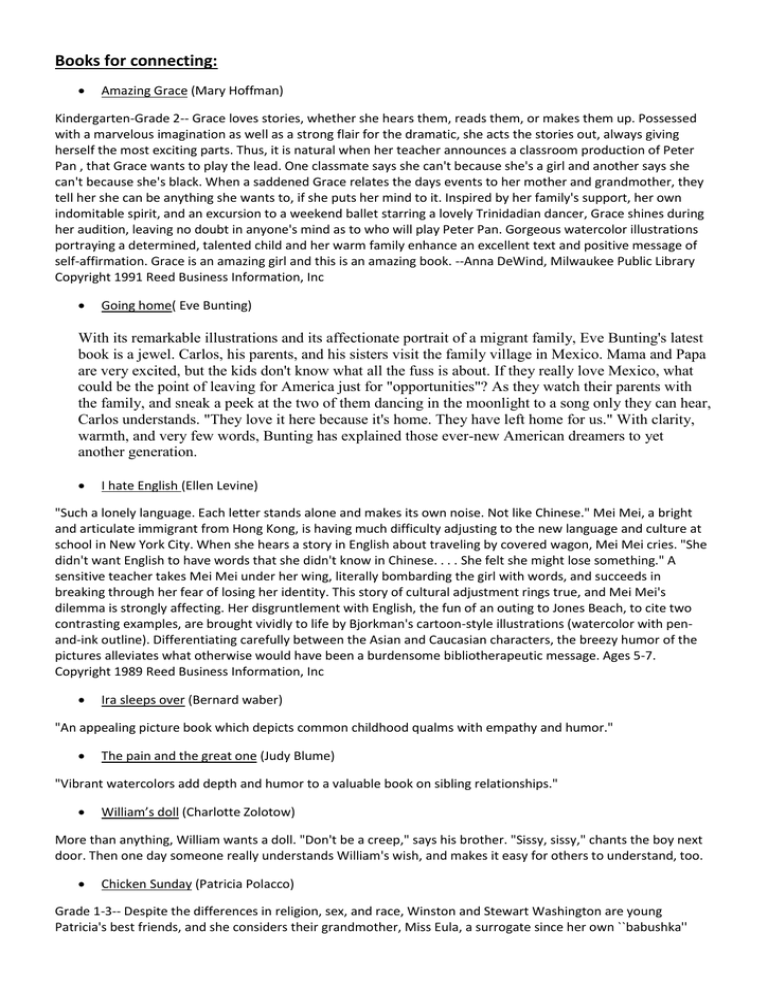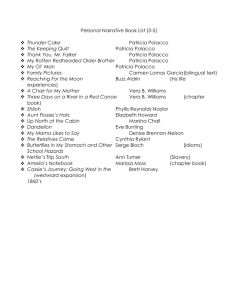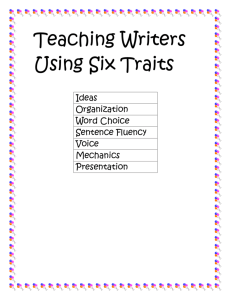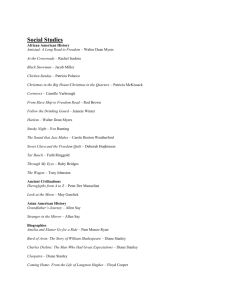Books for connecting
advertisement

Books for connecting: Amazing Grace (Mary Hoffman) Kindergarten-Grade 2-- Grace loves stories, whether she hears them, reads them, or makes them up. Possessed with a marvelous imagination as well as a strong flair for the dramatic, she acts the stories out, always giving herself the most exciting parts. Thus, it is natural when her teacher announces a classroom production of Peter Pan , that Grace wants to play the lead. One classmate says she can't because she's a girl and another says she can't because she's black. When a saddened Grace relates the days events to her mother and grandmother, they tell her she can be anything she wants to, if she puts her mind to it. Inspired by her family's support, her own indomitable spirit, and an excursion to a weekend ballet starring a lovely Trinidadian dancer, Grace shines during her audition, leaving no doubt in anyone's mind as to who will play Peter Pan. Gorgeous watercolor illustrations portraying a determined, talented child and her warm family enhance an excellent text and positive message of self-affirmation. Grace is an amazing girl and this is an amazing book. --Anna DeWind, Milwaukee Public Library Copyright 1991 Reed Business Information, Inc Going home( Eve Bunting) With its remarkable illustrations and its affectionate portrait of a migrant family, Eve Bunting's latest book is a jewel. Carlos, his parents, and his sisters visit the family village in Mexico. Mama and Papa are very excited, but the kids don't know what all the fuss is about. If they really love Mexico, what could be the point of leaving for America just for "opportunities"? As they watch their parents with the family, and sneak a peek at the two of them dancing in the moonlight to a song only they can hear, Carlos understands. "They love it here because it's home. They have left home for us." With clarity, warmth, and very few words, Bunting has explained those ever-new American dreamers to yet another generation. I hate English (Ellen Levine) "Such a lonely language. Each letter stands alone and makes its own noise. Not like Chinese." Mei Mei, a bright and articulate immigrant from Hong Kong, is having much difficulty adjusting to the new language and culture at school in New York City. When she hears a story in English about traveling by covered wagon, Mei Mei cries. "She didn't want English to have words that she didn't know in Chinese. . . . She felt she might lose something." A sensitive teacher takes Mei Mei under her wing, literally bombarding the girl with words, and succeeds in breaking through her fear of losing her identity. This story of cultural adjustment rings true, and Mei Mei's dilemma is strongly affecting. Her disgruntlement with English, the fun of an outing to Jones Beach, to cite two contrasting examples, are brought vividly to life by Bjorkman's cartoon-style illustrations (watercolor with penand-ink outline). Differentiating carefully between the Asian and Caucasian characters, the breezy humor of the pictures alleviates what otherwise would have been a burdensome bibliotherapeutic message. Ages 5-7. Copyright 1989 Reed Business Information, Inc Ira sleeps over (Bernard waber) "An appealing picture book which depicts common childhood qualms with empathy and humor." The pain and the great one (Judy Blume) "Vibrant watercolors add depth and humor to a valuable book on sibling relationships." William’s doll (Charlotte Zolotow) More than anything, William wants a doll. "Don't be a creep," says his brother. "Sissy, sissy," chants the boy next door. Then one day someone really understands William's wish, and makes it easy for others to understand, too. Chicken Sunday (Patricia Polacco) Grade 1-3-- Despite the differences in religion, sex, and race, Winston and Stewart Washington are young Patricia's best friends, and she considers their grandmother, Miss Eula, a surrogate since her own ``babushka'' died. On Sundays, she often attends Baptist services with her friends, and Miss Eula fixes a sumptuous fried chicken dinner with all the trimmings, after stopping to admire the hats in Mr. Kodinski's shop. The youngsters hope to buy her one, but when they approach the merchant looking for work, he mistakenly accuses them of pelting his shop with eggs. To prove their innocence, the children hand-dye eggs in the folk-art style that Patricia's grandmother had taught her and present them to the milliner. Moved by the rememberance of his homeland, the Russian Jewish emigre encourages the children to sell the ``Pysanky'' eggs in his shop and rewards their industry with a gift of the hat, which Miss Eula proudly wears on Easter Sunday. Polacco's tale resonates with the veracity of a personal recollection and is replete with vivid visual and visceral images. Her unique illustrative style smoothly blends detailed line drawing, impressionistic painting, primitive felt-marker coloring, and collage work with actual photographs, resulting in a feast for the eyes as filling as Miss Eula's Chicken Sunday spreads. The palette is equally varied, while the application of color is judiciously relieved by sporadic pencil sketches. An authentic tale of childhood friendship. --Dorothy Houlihan, formerly at White Plains Pub . Lib . , NY Copyright 1992 Reed Business Information, Inc Thank you Mr Falker (Patricia Polacco) Kindergarten-Grade 4 Once more Polacco shares a personal story with engaging results. This moving saga of her struggle with a learning disability makes an inspiring picture book. Young Tricia wants desperately to read but when she starts school she finds that the words "wiggle" on the page. Teased by her classmates, she retreats into dreams and drawings. It's not until the family moves to California and Tricia has managed to reach the fifth grade that a new teacher finally recognizes her pain and distress. What's more, he does something about it. Without belaboring the point, the author clearly shows the ways that children internalize critical comments made by others and suffer for their differences. This touching story is accompanied by illustrations in Polacco's signature style. Youngsters, as well as adults, may find themselves choked up at the emotions so eloquently described in words and pictures. Yet, like the tears young Tricia cries at the end of the book, these are ultimately tears of joy. Thank you, indeed, Mr. Felker (the real name of the teacher involved) for making it all possible. Readers will be grateful for the chance to recognize, appreciate, and share in Polacco's talent and creativity.ALisa Dennis, The Carnegie Library of Pittsburgh, PA Copyright 1998 Reed Business Information, Inc






